Microsoft Surface Pro 3 vs MacBook Air: Which is best?
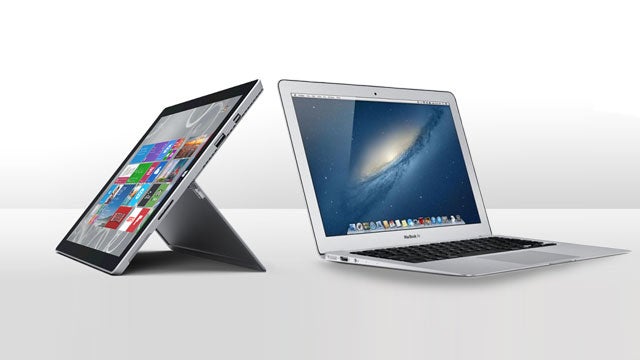
Surface Pro 3 or MacBook Air? Can Microsoft’s tablet/laptop hybrid really compete with the Apple laptop?
Microsoft believes the Surface Pro 3 hybrid offers the best of a tablet and a laptop. More specifically, the company is sure that it can replace the MacBook Air, which has been the go-to thin and light laptop in recent years.
While Apple has upgraded its super slim laptop recently and we still await to see if the Surface Pro 4 will turn up later this year, we see how the Pro 3 and the 2014 MacBook Air compares.
Watch our Surface Pro 3 video review
Surface Pro 3 vs MacBook Air: Design and Portability
Microsoft Surface Pro 3 – Tablet, 1.1kg (with keyboard)
MacBook Air – Laptop, 1.34kg
Despite being larger, this is the slimmest and lightest Surface tablet yet at just 9.1mm thin and 800 grams in weight. It’s still extremely heavy for a tablet, but it’s light compared to laptops.
But that figure doesn’t include the keyboard, and it really ought to. With the keyboard the Surface Pro 3 weighs 1.1kg, around 200 grams less than the 1.34kg 13-inch MacBook Air.
SEE ALSO: Apple MacBook (2015) vs Microsoft Surface Pro 3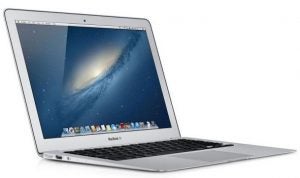
While the MacBook is slightly larger and slightly heavier than the Surface Pro, it’s hard to argue the latter is more portable as a result. They both need a similar size bag to carry them in and the differences in weight are the matter of a couple of hundred grams. You’ll notice the difference between the two, but the Surface Pro isn’t more portable as a result.
The MacBook Air also has a slight edge here. Innovative as the kickstand design on the Surface Pro 3 is, it’s useless in cramped commuter settings like trains and planes. Indeed, the design of a typical economy class tray table is incompatible with the kickstand as there’s a large gap where the stand needs to sit. It’s also awkward, though not impossible, to use on your lap.
SEE ALSO: Best Laptops, Ultrabooks and Hybrids
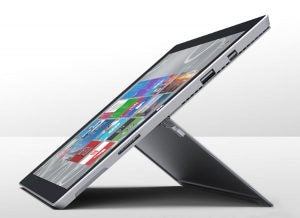
Overall, there is no real winner here. They’re different enough that it really comes down to what kind of device you really want and need.
Surface Pro 3 vs MacBook Air: Screen
Microsoft Surface Pro 3: 12.1-inch, 3:2 aspect, 2160 x 1440 (216ppi), touchscreen
MacBook Air: 13.3-inch, 16:10 aspect ratio, 1440 x 900 (128ppi)
This is not a contest: the Surface Pro 3 has a fundamentally better screen. It’s much sharper, has a higher resolution and its 3:2 aspect is very helpful when using traditional desktop applications. It also has superior contrast and punchier, richer colours.
In contrast, the MacBook Air’s screen is serviceable but beginning to show its age. It’s bright, but the resolution is disappointing and the panel quality is so-so. It’s overdue an upgrade.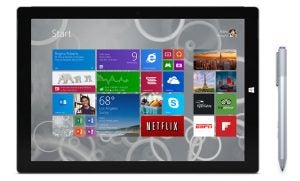
Surface Pro 3 vs MacBook Air: Specs and Performance
Microsoft Surface Pro 3: Intel Core i3/i5/i7, 4GB or 8GB RAM, Intel HD Graphics 4400, 64GB/ 128GB/256GB/512GB storage
MacBook Air: Intel Core i5/i7, 4GB or 8GB RAM, Intel HD Graphics 5000, 128GB/256GB/512GB storage
If we take similar prices and specs, which means the entry-level MacBook and the first Core i5, it’s hard to choose between the two. They achieve very similar scores in the Geekbench 3, 5,401 on the MacBook and 5,532 on the Surface Pro 3. This only tells a limited story, though.
The Surface Pro 3 has the faster processor, clocking in at 1.9GHz and the ability to Turbo Boost a single core to up to 2.9GHz. The MacBook, in contrast, has two 1.4GHz cores with up to 2.7GHz Turbo Boost. They’re both Haswell processors.
This gives the Surface Pro 3 an edge in processor intensive tasks, such as image editing, but the MacBook has other advantages. It has a faster solid state storage and uses the marginally faster HD 5000 graphics over the HD 4400 GPU in the Surface Pro 3.
They’re both very good performers, just in slightly different ways, though we’d give it to the Surface Pro 3 if pushed.
SEE ALSO: Surface Pro 3 vs Surface Pro 2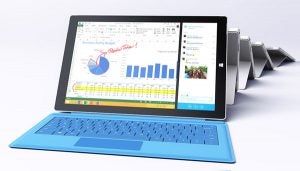
Surface Pro 3 vs MacBook Air: Connectivity
Microsoft Surface Pro 3: 1x USB 3.0, 1x MiniDisplayPort, microSD (up to 128GB)
MacBook Air: 2x USB, 1x Mini DisplayPort/Thunderbolt 2.0, SDXD (up to 128GB)
Here, the MacBook Air edges things a little. It has two USB ports and a full-size SD card slot against the single USB and microSD slot of the Surface Pro 3. The MacBook also has a Thunderbolt 2.0 port (it doubles as a Mini DisplayPort).
That full-size SD card slot is a serious point for us. A microSD card slot isn’t much use if you have a camera you want to use and makes the laptop replacement schtick ring hollow. There are adapters that allow you to use microSD cards in cameras with normal SD card slots, but you won’t get the same performance. It’s a forced compromise we’d rather avoid.
Wireless connectivity is identical as both feature Bluetooth 4.0 and 802.11ac Wi-Fi.
Surface Pro 3 vs MacBook Air: Windows or Mac OS X?
Microsoft Surface Pro 3: Windows 8.1
MacBook Air: Mac OS X 10.9 Mavericks
The likelihood is you’re either a Windows person or a Mac person, which renders this debate slightly moot. That said, at present Mac OS is a more coherent operating system than the awkward hybrid of Windows 8. Of course, the Surface Pro 3 tackles this hybrid approach better than most, but there are still problems.
The biggest one here is application scaling. Microsoft still hasn’t found a way to make more desktop apps work better with high resolution displays, and the Surface Pro 3 has a very high resolution display.
Another advantage in Mac OS is the tight integration of multi-touch gestures and virtual desktops, two features that make easier to be productive on a small screen.
We’re not calling a winner here, though.
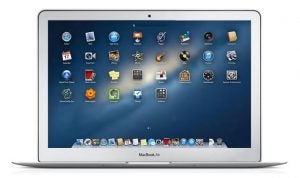
Surface Pro 3 vs MacBook Air – Battery Life
Microsoft Surface Pro 3: 7-9 hours
MacBook Air: 10-12 hours
This is the MacBook’s main strength. It’s good for 12 hours of light use and web browsing and 10 hours of mixed use and video viewing, which is incredible. The Surface Pro 3’s seven to nine hours is still very good by normal measures, but the MacBook is in a different class.
Surface Pro 3 vs MacBook Air: Other things to consider
There are one or two things the above don’t cover that we ought to recognise. One is the Surface Pro’s pen. It’s very accurate and easy to handle, making it great for hand-written notes and other creative inputs. Whether this matters comes down to what you need. Some people will love it, some people won’t use it. If you’re in the former camp, however, this is a serious pro in the Surface Pro’s favour.
Another factor is the keyboard. The Surface Pro’s keyboard cover is immensely impressive, but the MacBook’s firmer ‘real laptop’ feel gives it a slight edge. If most of your time is spent writing emails, reports and the like then the MacBook Air is the one for you.
Next, read our best Windows laptops and tablets round-up
Surface Pro 3 vs MacBook Air: Which is best?
Pitting the Surface Pro 3 against the MacBook Air is a neat marketing ploy from Microsoft and it scores some decent hits. It has a much better screen and is thinner and lighter.
The MacBook wins on battery life, connectivity and — in some cases — practicality. It’s also a little cheaper when comparing like for like as the entry-level 13-inch MacBook costs £849 while a comparable spec Surface Pro costs £958 once you include the ‘optional’ keyboard.
But if this comparison proves anything it’s that this is the wrong question. You can’t really say which is better than the other because the experience is fundamentally different. The right question is whether you can really replace a laptop with a hybrid.
Not everyone will have the same answer, but we wager the majority will still find a laptop, MacBook or not, more practical. The Surface Pro 3 is an interesting and very accomplished alternative, but you must really need its alternative strengths to tolerate its other weaknesses.
Related: Microsoft Surface Pro 4 review

